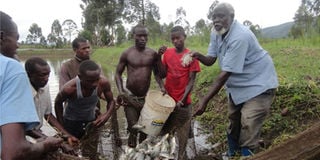Prime
Aqua farming: Starting and managing fish ponds

A fish farmer in Isingiro shows the catch from one of his ponds. Fish farming in Uganda is a lucrative business that has a lot of potential if exploited properly. File Photo.
What you need to know:
With increased interest in aquaculture or fish farming, many Ugandan farmers are making investments to take advantage of the market opportunities. Lominda Afedraru sought a few tips for the farmers from the experts.
Fish farming is becoming a lucrative business with a good number of farmers engaged in this activity with the view of increasing their household income.
And to earn big from this business, farmers are advised to construct a number of ponds to enable a good harvest taking into account the element of proper management.
When preparing a fish pond, farmers must take into consideration the lowest possible risk surrounding the land such as rainwater run-off and flooding that may end up destroying the pond.
Setting up
Before building your structure you should assess the design of the foundation, the ridges, inlets and outlets. The intake and discharge points should be built using concrete blocks possibly rock armouring and other design solutions to minimise erosion and leaks around intake and discharge points.
Mark Mubiru, a fish farmer in Mpigi District, says constructed ponds should be treated with lime to ensure no water leaks.
The lime should be left for three to four days before water is introduced. In addition, the farmer can fertilise the water by either using chicken droppings or artificial fertiliser. It will turn the water green and after two weeks, the fingerlings can be introduced into the pond. The application of fertiliser is meant to neutralise the acidity in the water.
Most of the ponds constructed are 40 by 20 metre ponds and the stocking of fish should be three to five fingerlings per metre.
Inspections
“When the fingerlings are put into the pond, begin feeding them straight away. The best feed is the one made at the National Fisheries Resources Research Institute (NaFRRI) in Kajjansi,” he said.
It is necessary for farmers to monitor their pond structures after they have been built to make sure they are working properly. This is also to assess the impact of the structures on the environment by checking for potential leaks, embankment instability and contamination of pond water.
Regular visual inspections should be carried out to identify any potential problems. And groundwater monitoring helps identify significant problems with the containment structures.
Fish farmers in Uganda mostly breed Tilapia and catfish species because they are the most consumed by customers although Tilapia is economically viable.
Farmers are free to keep both tilapia and cat fish species in the same pond but the Tilapia must be mature to avoid the catfish from feeding on them. However, if a farmer feels his or her Tilapia fish pond is overcrowded, catfish can be put into the same pond to feed on the young Tilapia to reduce their population.
Costs
A number of farmers keep catfish because it is cheaper to feed them and they are capable of feeding on anything including chicken intestines. By the sixth month, farmers can harvest fish from their ponds depending on how well they were being fed.
The costs of constructing a fish pond may range from Shs1m and upwards depending on how big the pond is. It is influenced by the hire price for the excavation and managing the pond is also labour intensive. Fingerlings can be purchased from NaFRRI with each one costing Shs200.
However, according to Mubiru, using cages is more yielding than the open pond because a farmer is capable of monitoring growth of the fish in a cage and it is not labour intensive.
The other advantage is that at harvest time, the cage(s) is/are pulled out of the water and loaded into a vehicle/vehicles, ready to be taken to the market.
Fish farmers should seek expert advice on fish farming from scientists at NaFRRI, which is located in Kajjansi.
The institute is involved in breeding species such as Tilapia, Nile perch, African catfish and common cap fish species, the latter were imported from Asia.
Establishment
In order for the scientists to supply farmers with quality fish seed, they carry out laboratory tests to establish the quality of the water before filling the ponds for the breeding process.
The research team also ensures that once in the pond, the different fish species are fed with the right type of feed, which comprises mixtures of sunflower cake, cotton seed cake and soy bean.
Godfrey Kityo, a research technician at NaFRRI, says apart from breeding the different fish species and supplying them to farmers, the researchers also sensitise them on the best aquaculture practices for managing and getting the best from the fish ponds.
The farmers are also trained on construction of ponds, breed the different fish species, marketing them both locally and internationally as well as produce the feeds.
They are advised to establish ponds where there is a nearby source of water and the pond must have clay soil and contain the necessary nutrients for the fish species that the farmers have opted to rear.
Breeding
“Apart from supplying the farmers with the fish seed, we also make the different types of feeds both in powder and crystal form which we supply to the farmers. We sell one kilogramme of the feed at Shs2,500,” Kityo says.
The breeding process of Tilapia, Nile perch and African catfish takes place naturally but the common cap fish species do not breed naturally in the water bodies here. What the scientists do is to induce a hormone in the fish to activate its feeding characteristics.
The head of aquaculture research, Dr Dismas Mbabazi says the institute is mandated to breed and supply disease-free fish seedlings to the farmers and as such, the scientists usually test for bacterial diseases, which cause rotting in the gills and intestines of the fish.




